page 7
(Using a philosophy of "threes" as a tool
for dissection and comparative analysis)
http://threesology.org
Anat., Bio. Phys. Researchers as of 3/17/2021
Pages in this series:
| 1 | 2 | 3 | 4 | 5 | 6 | 7 | 8 | 9 | 10 | 11 |
Before getting into some widely known generalities of memory, let me take a moment to make an analogy to the three stop and one start codons of DNA and RNA. If we view them as sequences of memory, "something" has encoded them to stop or start. Not only is the foundation triplet code remembered again and again to appear... apparently for most organisms, but so is the 3-to-1 ratio. If the sequences are expressions of memory, then something is sustaining the memory over a vast array of different organisms for billions of years. In other words, if we look to the environment as the mechanism which initially influenced and currently influences the recurrence of this (or these) dream sequences, there must be a pattern-of-three that is attached to or has an accompanying 3-to-1 event as well. Unless of course the event(s) which initially influenced the development of the triplet code is no longer around and the recurrence of the three and 3-to-1 is a reverberation through time... like the undulations of water after a pebble is dropped into it.
The three moments of the Sun (dawn-noon-dusk) and their eventual fusion (as experienced from our vantage point on Earth due to the Sun's expansion and the Earth's slowing rotation... coupled to the recession of the Moon), are an example of this combination... but does not mean this particular event is THE or ONLY causal factor. If we accept the idea of codon sequencing as memories, it is not too difficult to view the stop and start of other physical processes as expressions of biological memory as well. Nor can we exclude the expansion of the Universe, the rotation of planets, or change of seasons... even though we describe them in other terms for other reasons. The recurrence of a seasonal event can be viewed as a memory, just as the re-growth of hair, nails and cells. Just because we customarily assign the notion of memory to human, animal or even plant biology with various constraints related to someone's use of psychology, does not mean that nature imposes the same restrictions. The many egocentricities of humanity cause a lot of problems in understanding the laws of nature (aka "God"), and how they are subject to change through reinterpretations not skewed by human nonsense such as found in many religious texts which use such words as spirituality, divinity and sacred as a means of concealing human self-centeredness. Part of this nonsense is not to see the 3-to-1 sequences as a memory recorded in biological process about an environmental event that is undergoing change, despite the ubiquity and duration of the 3 to 1 ratio. And yes, the double-faced symmetry (or asymmetry) is another memory as well.
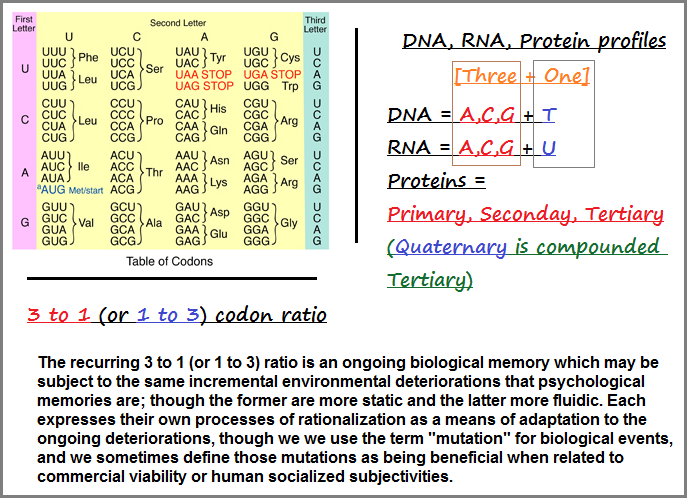
Here's a link about protein structure: Protein Structure
Memories are altered by time due to deteriorations, by succeeding events, or reinterpretation. As deteriorations occur, there is the occasion by which parts of a memory can become used to represent the whole, though the memory's title may not be accordingly changed to record the amount of alteration... due to deterioration, that has taken place. Because the title of a memory is being used as a preliminary descriptive, one can image that there has been no change in the memory or one's remembrance of a memory, when actually there has been, and the memory of another who recalls what was portrayed earlier, may be forced to abide by the deterioration as a means of humoring a person as they age. Indeed, the memories many of us have had with respect to historical narratives becomes altered by forgetting, or by the features of additional references due to uncovered information that was not used when the memory was initially encoded with accompanying mechanisms of recall that were linked thereto. Some memories get better in the sense they are more refined to suit a particular frame of mind that may have at one time exhibited a care-free happy-go-lucky perspective, but was altered in accord with academic or personalized training, such as in the case of a job requirement or personal research project, be it one in which additional information or experience is acquired due to reading about how to repair an appliance, piece of furniture, bake or cook, build this or dismantle that, rebuild a gas engine or electric motor, wire a fuse box, conduct a survey, struggle with computer issues, work multiple jobs, experience multiple injuries, accidents, illnesses, etc...
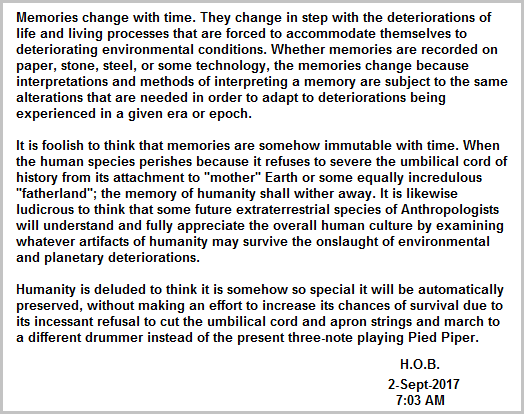
When looking at memory, we discover various patterns-of-three, but there are other patterns as well. One recurring pattern is the usage of dichotomies or polarities such as the implicit and explicit systems of long term memory. And yet, if we look at the terms "Explicit" and "Implicit" and apply them to personal experiences, many of us might want to make a case for a semi-conscious form of memory which artists, poets, musicians, scientists, etc., would attest to with respect to creativity and originality of thought and that we might, for the sake of discussion and reference, label as "ExImplicit" memory, that has been applied to an image which once contained only descriptions for Explicit and Implicit memory. As such, some of the dichotomies might well be "upgraded" to trichotomies if we took the time to reconsider them in a broader perspective.

Wikipedia: Explicit memory
Yet, the study of memory is the study of cognitive limitation, like so many other research efforts... which do not ponder the question of what is creating the conditions for limitation... and there is a general assumption that human physiology alone is responsible, instead of being imposed upon by an incrementally deteriorating environment. So let us look at memory with a broader perspective than typically found in conventionalized portrayals by those who may be oblivious to the usage of viewing research models from an enumerative design of collation. (In other words, by looking at the implied number patterns and correlating them to other cognitive interests, which provides a measuring tool of how limited we actually are in our conceptual processings, though we might well defend them as some absolute representation of the isolated interest in a given material being examined.)
Three types of memory:
Three ways to access memory:
3 mental states of memory:
3 atomic particle states of memory:
3 general categories of memory:
Three phases of Neural activity:
Three types of Neurons:
Three to one ratio: Neurons either fire or they Cannot fire at 50%, 75%, 2% Peripheral Nervous System |
|
Patterns-of-two we can associate with memory (even if some of the relationships are not familiar or are untypical for you to use). While in some cases I have include the word memory or its correlates, I have not done so in others. Please include them as part of dichotomy. In all examples, it is not too difficult to image some central position, or that an intermittent position is already defined but not one point of the extreme, such as in the case of the example "Continuous/ Intermittent", which is one extreme and the middle position but not the other extreme. Howevee, for other examples of a dichotomy, there are two images of dichotomies on this page (Home page, and here: Persistent Dichotomies)
|
|
With respect to the last example, the dichotomy might be better understood if an example if at least one side of the coin is provided for, even if the obverse as not been explored with the same degree. Here is an extracted excerpt from a wikipedia article (notice the "one-to-many" reference in the last sentence as a reflection of a primitive counting method): Collaborative Inhibition: When groups collaborate to share information, they experience collaborative inhibition, a decrease in performance compared to the memory performance of individuals. Basden, Basden, Bryner, and Thomas (1997) provided evidence that retrieval interference underlies collaborative inhibition, as hearing other members' thoughts and discussion about the topic at hand interferes with one's own organization of thoughts and impairs memory. Additionally, motivational mechanisms may also account for this memory deficit in groups due to social loafing. Explanations for this include:
However, it has been found that collective inhibition may be due to sources other than social loafing, as offering a monetary incentive have been evidenced to fail to produce an increase in memory for groups. Further evidence from this study suggest something other than social loafing is at work, as reducing evaluation apprehension – the focus on one's performance amongst other people – assisted in individuals' memories but did not produce a gain in memory for groups. Personal accountability – drawing attention to one's own performance and contribution in a group – also did not reduce collaborative inhibition. Therefore, group members' motivation to overcome the interference of group recall cannot be achieved by several motivational factors. Despite the problem of collaborative inhibition, working in groups may benefit an individual's memory in the long run, as group discussion exposes one to many different ideas over time. Working alone initially prior to collaboration seems to be the optimal way to increase memory. | |
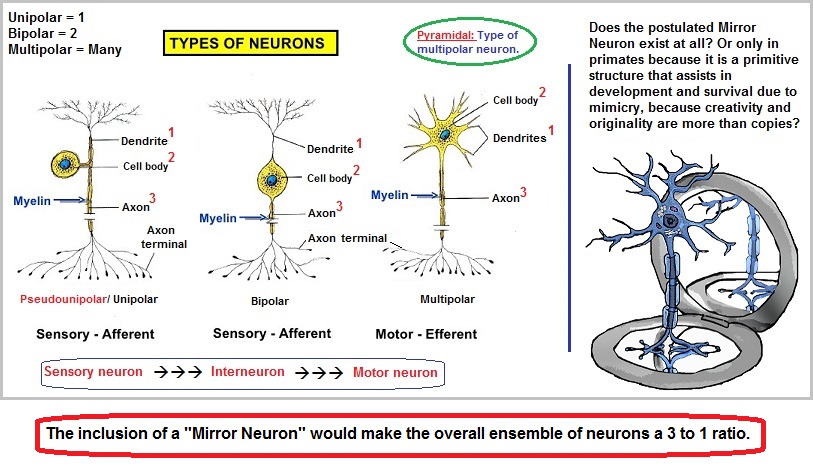
Here are two examples about the presence of "three" used in testing memory in individuals who may be labeled "participants", "subjects" or "patients". One indicates its presence in research and the e other how "threes" (along with 7s) may be used my mental health screeners to determine a person's relative thinking processes... that is, testing their ability to recollect both short-term and long-term memory. Yet, neither explains why such patterns are used, and if you were to ask such test givers, you might well receive some form of logical answered configured by rationalization. It would seem that the memory of professionals is focused on the usage of particular patterns, as if these were the primary standards of proof to elicit some hidden truth... such is the silliness in this day and age.
|
A classic experiment on fast forgetting was carried out by Peterson and Peterson (1959). They asked participants to memorize a three-letter sequence, then count backwards in sets of threes. Participants were then asked to try and recall the three-letter sequence after different lengths of time counting backwards. Participants did surprisingly poorly on this test. After only six seconds of counting backwards in threes, on average half of the original three letters had disappeared from memory. By the time participants had been counting backwards for 12 seconds, less than 15% of the original memory remained. Finally after 18 seconds it was all but gone. This experiment clearly shows how quickly information leaks out of short-term memory. So perhaps the book I was reading just went straight in and straight out again? No doubt a lot of it did, but surely some of it must have stuck. Otherwise I wouldn’t have been able to follow the story and would have ended up reading the first page again and again. A mini-mental status exam (also, "min-mental state exam") is a quick way to screen for confusion, cognitive problems, and possible gross neurological trouble. It's used in part to help determine whether more specific inquiry and testing should be performed. If you're in pretty good shape, it just seems a little weird. If you're not in good shape, it's very difficult. Tasks include spelling a word backward, copying a geometric figure, saying where you are, remembering three items for several minutes, and the like. "Serial 7s" wasn't part of the MMSE per se, but is sometimes tacked on or substituted for a different item. If you can't do serial 7s, you may be asked to try serial 3s. H.O.B. note: (One might suspiciously think this refers to counting backwards from 100 by 7s or 3s, because ones and twos and fives are too easy and you need a more difficult task to "prove" the state of mentality is not as they believe it should be... like being set-up for failure if you are particularly stressed, so they can take control and make money off your presence in their establishment under their care.) In some circumstances, much of information sought by the MMSE can be gleaned in the context of a basic intake interview. If a person's answers are impoverished or odd in certain ways, they might then be asked formal MMSE questions. If a person's cognition and memory appear grossly intact, there's no need for that. The intention is not to trick anybody, but rather to have an easy triage tool for situations where the person may not be able to tell you what's happened--a person with dementia, for example, or somebody who's fallen off a ladder. This was a clear, concise, and enlightening answer. Thanks, Shoshana, I didn't know that. As a resident I was taught to ask confused patients three orientation questions: 1) Who are you,2) Where are you, 3) What day is it. If they didn't pass #1 you didn't have to ask them #s 2 and 3. If they pass all three of them you get to write in the chart, "A&Oxiii", which is jargon for "Alert and oriented times three", which means mentally normal. Not as precise as the exam Shoshana described, is it? The knowledge of your own name is said to be very deep, and a person must be really sick or have something very seriously wrong with the brain to lose it. Where are you can be lost with mild dementia or moderately severe illness. What day is it can be lost by perfectly normal physicians writing to the Straight Dope. "Normal" in quotes, of course... |
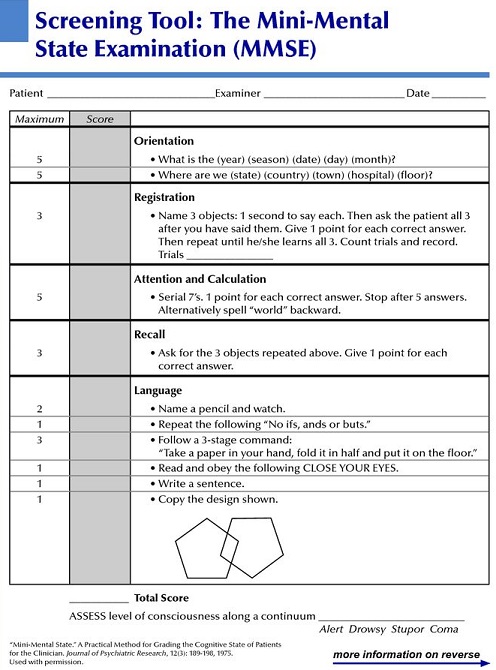 |
|
| The first image does not provide the question giver the answers for the serial sevens, while the next image does. Perhaps this is because the question was found to be too hard for most test givers and they needed the answers beforehand... like a cheat sheet, because if they were asked the question, they wouldn't be able to perform the task any easier, but would be provided allowances for mistakes because they are part of the staff. The questions do not allow the person to take a few moments to practice the subtraction math test. Nor is the question offered in the sense of permitting the person to add, multiply nor divide. | |
A Memory-making process model
|
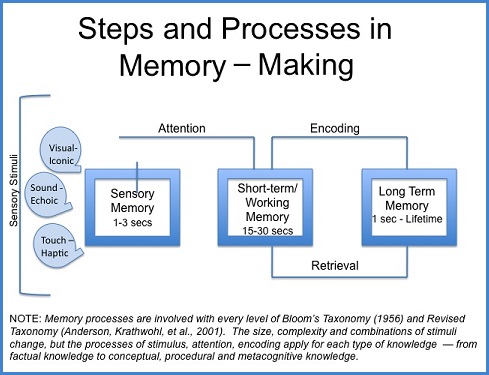 Designing For Learning |
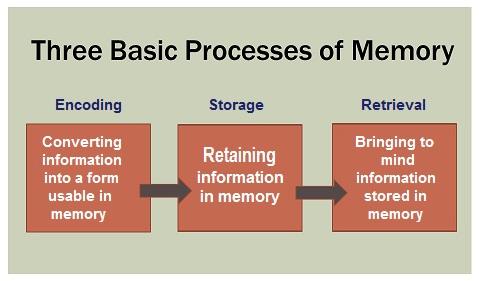 Memory |
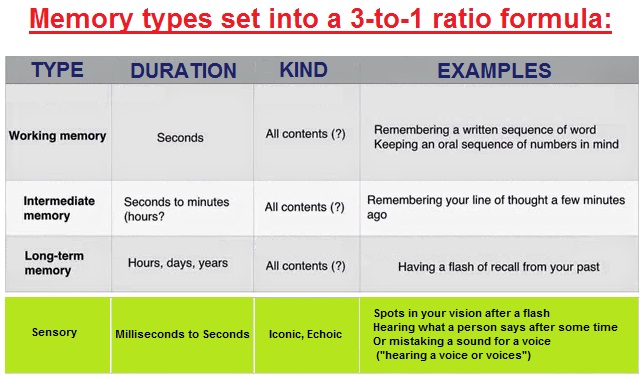 |
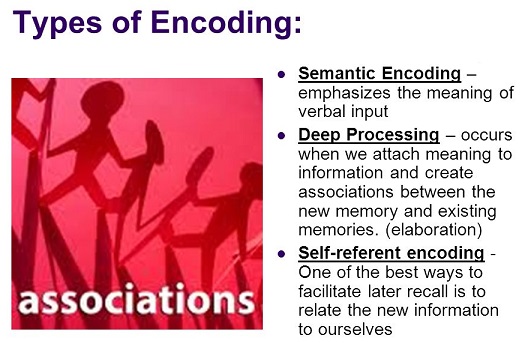 Memory |
 Designing for Learning |
Top-to-Bottom information arrangements using the words "tree" and "diagram" though other words are available, such as scaffolding, staircase, mountain range, etc...; which describe a limitation in the use of words and ideas towards illustrating memory, and thus implies that memory actually "works" like this and there is no inscribed allowance for presenting alternative models.
Hierarchical "diagram" designated model of memory types with enumerated time differentiations: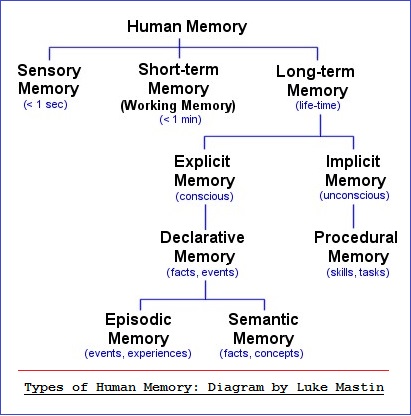 The Human Memory What it is, How it works, What can go wrong |
Hierarchical "tree" designated model of memory types without enumerated time differentiation: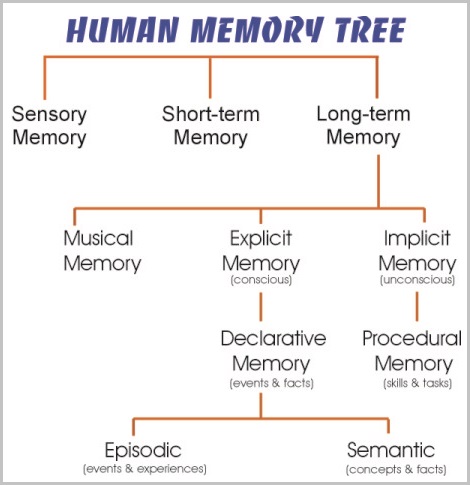 Memorize: Memory Expert and Memory Speaker |
With respect to types of memory, an acknowledgement of the adaptive ability to distinguish between animate and non-animate realities has evolutionary survival value. However, such a perspective does not typically include the reality of supposition that all of us may wrestle from time to time with at varying stages of life, such as the memory we unacknowledgingly impart to such ideas as god, ghosts, spirits, demons, monsters, some nameless "thing, presence, entity, shadow, changeling", extraterrestrial, etc... Hence, many of us, from childhood onward, have wrestled with three types of generalized distinctions where the idea of memory is applied, even if we do not directly think about having imprinted the ability... the functionality of memory onto inanimate and "numinous" or "ephemeral" or "faint" (scared or otherwise) entities. Here's an article that typifies the evolutionary practice of a cross-generational memory of distinguishing between the animate and inanimate, but is atypical in that it does in fact make an acknowledgment of what most of us take for granted... but once acknowledged, the simplistic behavior which humanity engages in is readily understood: Alternatively: Adaptive Memory: The Mnemonic Value of Animacy (August 6, 2013)Note: like most research methods, the usage of an enumerated form of an analysis is applied. As with conventional research projects, the usage of numbers as an analytical tool remains encased in the respective matter of a given subject. However, if one uses numbers to analyze the material of multiple subjects, the approach is deemed unconventional and may be referred disparagingly to as "numerology", because the initial stages of constructing a greater level of research rigor is not permitted to develop, though every single subject today has had to undergo fledgling steps of hit and miss development like every single practice, be they of a sport, medicine, construction trade, mathematics, public speaking, etc... Whereas a person may be permitted to analysis the analysis of one researcher or multiple researchers of a given subject area, this is not necessarily the case for those like myself who strive to analyze large quantities of information from divergent subject areas. "Threesology research" is involved with the collection and analysis of "Big Data". It is a research methodology being developed for usage in multiple areas such as evolutionary biology, statistics, economics, demographics, etc... All of them are in the early stages of developing the protocols for collection, analysis and application... including the development of computer programs to handle such large collections. It is a new territory that "Threesology" is very much a part of, even if those who come to this site do not appreciate this fact. In a discussion of memory types we need also to describe what we label inanimate forms of memory such as the memory of water, of metal, of batteries, of worms, of plants, bacteria, viruses, etc... Indeed, an enlargement of our definition involving the general usage of the word "memory" might even create an expansion to include molecular interactions, nuclear decay, etc..., just as we due to such ideas as habituation, classical conditioning, pain/pleasure sensations, etc. The word "repetition" may not always be appropriate, and the many types of memory may not be seen because we do not experience an occasion to record an event which we might describe as memory in general or specific ways. | |
|
Random Examples of Memory ideas: Cognition: Memory and its parts Science News: 3 layers of working memory4 types of memory: Juan Volpe: Why is it so important to remember? Queensland Brain Institute: Types of Memory Stanford Encyclopedia of Philosophy: Memory 3 things you need to know about memory Not only is there a perceived limitation but a perceived limitation in how we portray limitation and our acknowledgment thereof. (Our acknowledgment thereof is limited.) |
|
If we expand upon the above simple line drawing presenting us with two forms of memory, one of which is elaborated on, and include a third as well as identical elaborations for the other two, we can come up with the following image. In addition, we can imaginatively consider that memory can assume various types of platforms upon which to ascend or descend from consciousness, as well as duck behind the stairwell so-to-speak:
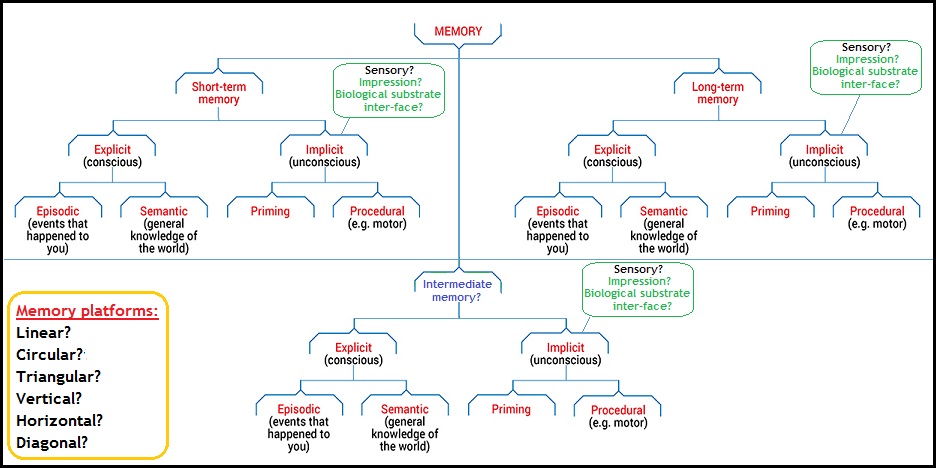
|
Because there is a precedent for biologically-based phenomenon to exhibit a physical dimensions of bilateral symmetry, it behooves us to consider the existence of or eventual existence of a psychological counterpart with a dimension of physicality. In other words, is there or will eventually be a mirror-image to the structure of memory that we now see, such that it mimics the arrangement and assignment seen in particle physics? | |
| 3 basic forms of particles | 3 basic forms of memory? |
| 3 families of fundamental particles (stable, unstable, highly unstable) | 3 families of fundamental memory? |
| 3 flavors and colors of particles | 3 flavors and colors of memory? |
| Particles in a shell configuration | memory in a shell configuration? |
| 3 fundamental forces (strong/weak, gravity, electro/magnetic); | 3 fundamental forces in memory? |
| 3 dimensions (with consideration of others); | 3 dimensions of memory? |
| 3 charge states of particles (positive-neutral-negative); | 3 charge states of memory? |
| Existence of a postulated dark matter with corresponding particle; | |
| Existence of a postulated dark (or grey) area with corresponding part in memory? | |
| Bi-lateral symmetry of Matter and anti-matter in physics; | Bi-lateral symmetry in memory? |
| 3 postulates (spin, position, direction) for particles; | 3 postulates for memory? |
In a discussion of memory, let us briefly mention those ideas surrounding instincts and reflexes. Are they memories encoded in physiology... even though we have no conscious recollection of the particular experiences which established them? Does a relative recurring consistency in the environment and developmental biology create conditions by which such forms of memory are effectively recalled and not extinguished? And what about environmental sequences of events? Are they memories... that is, if we broaden our application of the term "memory" to represent any formula of repetition? And if we apply a linear, circular, triangular model to the notion of memory, does a sequence of seasons occur in a linear, circular or perhaps triangular formula... or something altogether not considered, and our present illustrations are particularly primitive?
 Seasons placed into a linear configuration |
 "Squared" seasons, or unseen functions involving diagonal, horizontal, vertical views. |
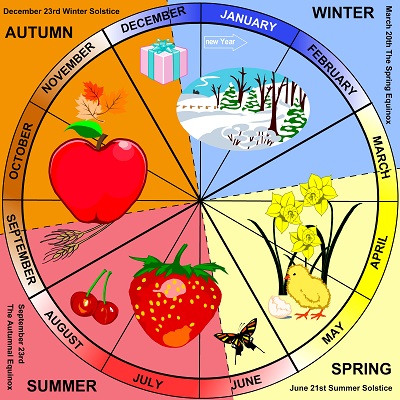 Seasons placed into a circular configuration |
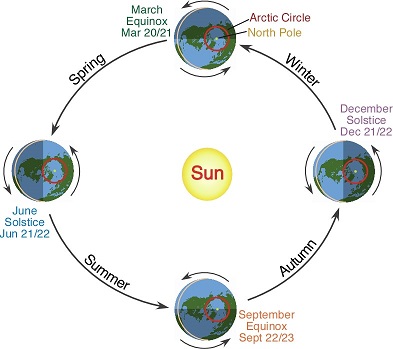 Seasons described in terms of a circular planetary movement |
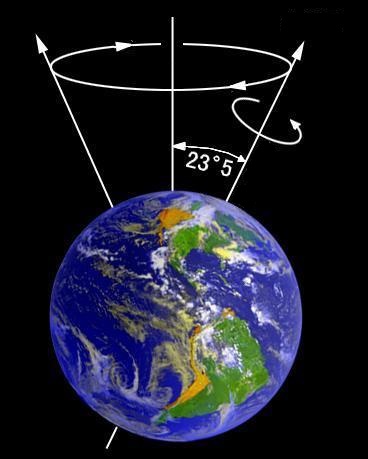
Another type of memory that should be spoken of is the common 2X 23 (46) chromosomes found in individuals. Those with 45 or 47 chromosomes can have undesirable mutations, one of which is downs syndrome. However, when speaking of chromosomes, the terms monoploidy, diploidy, triploidy, etc., are used. Those with more than three may be lumped into a single terms such as "polyploidy", similar to the "many" (plenty, heap, much) term which could be used by primitive peoples in their vocalized counting sequences. The main point of this particular digression is to correlate the 23.5 degree tilt of the Earth on its axis with the "23" number in chromosomes. Clearly the measurement may slightly deviate from time to time, thus providing for a possible environmental influence on genetics. Whether such a correlation has any validity or not, I thought I would bring it up so some readers might think of it from time to time while they catalogue other numerical indices which may (or may not) have applicable value in some instances. Nonetheless, the correlation is close enough to be included in our scrutiny of numerological comparisons... and is a type of mathematical investigation even if mathematicians or (in this instance) biologists refrain from this type of intellectual considerations. However, let's look at some definitions of different chromosome number, keeping in mind that the overall quantity is conserved, thus revealing another example of an underlying limitation based on the evidence provided: |
|
| Number of chromosomes | Name | Description |
| 1 | Monosomy | Monosomy refers to lack of one chromosome of the normal complement. Partial Monosomy can occur in unbalanced translocations or deletions, in which only a portion of the chromosome is present in a single copy (see deletion (genetics)). Monosomy of the sex chromosomes (45,X) causes Turner syndrome. |
| 2 | Disomy | Disomy is the presence of two copies of a chromosome. For organisms such as humans that have two copies of each chromosome (those that are diploid), it is the normal condition. For organisms that normally have three or more copies of each chromosome (those that are triploid or above), Disomy is an aneuploid chromosome complement. In uniparental Disomy, both copies of a chromosome come from the same parent (with no contribution from the other parent). |
| 3 | Trisomy | Trisomy refers to the presence of three copies, instead of the normal two, of a particular chromosome. The presence of an extra chromosome 21, which is found in Down syndrome, is called Trisomy 21. Trisomy 18 and Trisomy 13, known as Edwards Syndrome and Patau Syndrome, respectively, are the two other autosomal trisomies recognized in live-born humans. Trisomy of the sex chromosomes is also possible, for example (47,XXX), (47,XXY), and (47,XYY). |
| 4/5 | Tetrasomy and pentasomy are the presence of four or five copies of a chromosome, respectively. Although rarely seen with autosomes, sex chromosome tetrasomy and pentasomy have been reported in humans, including XXXX, XXYY, XXXXX, XXXXY and XYYYY. |
Polyploidy: Definition & Types - Video & Lesson Transcript | Study.com
Page initially created: Friday, 19-August-2017... 3:35 AM
Initial Posting:
Wednesday, 27-September-2017... 9:27 AM
Most Recent update: Friday, 17th, March 2023... 10:41 AM
Herb O. Buckland
herbobuckland@hotmail.com
